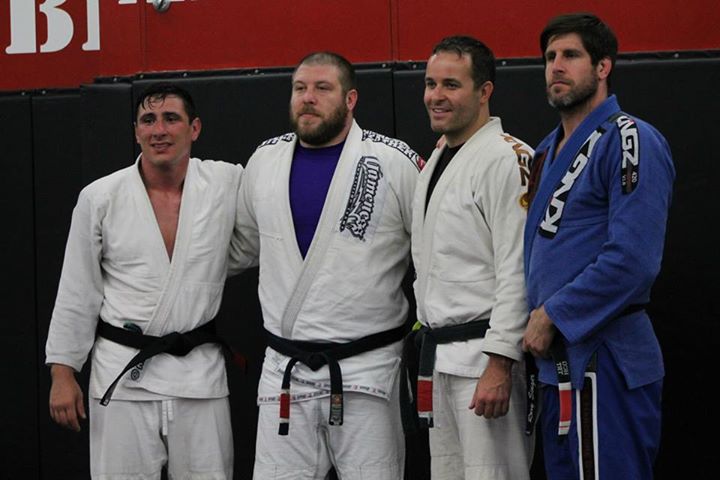Stephan: I’m here today with my friend, Adam Singer, who runs The HardCore Gym in Athens, Georgia. He is probably best known for being Forrest Griffin’s MMA coach during the formative years of Forrest’s career. He’s also a jiu-jitsu black belt and has trained tons of fighters.
I’m really looking forward to picking his brain about MMA and jiu-jitsu and the relationship between these things. He’s an outspoken guy, so I’m sure we’ll have a good conversation.
The best thing to do is to subscribe to The Strenuous Life Podcast using the podcast player that you almost certainly already have on your phone!
(For example, if you have an iPhone then it’s the purple app with the antenna-like thing in it. Just click the Apple Podcasts link below and it should open up that app for you.)
Here are the links to find the podcast on various players (This one is episode 22)…
- Apple Podcasts (the purple app on your iPhone)
- Google Podcasts (the new google podcast app)
- Spotify (it’s free)
- Stitcher,
- Soundcloud,
- Google Play
Thanks for talking to us today Adam!
Adam: Hi. It’s a pleasure to be here.
Stephan: So, you’re driving around town as we do this interview?
Adam: It’s hard for me to find any place where I’m not going to be bothered by people. And so I figured, I’ve got the air-conditioner on in the car and I’m just going to drive around. We have what is called “The Loop”. It’s about 10 miles long and I’m just going to drive around “The Loop” with cruise control on and talk to you.
Stephan: Okay. Well, hopefully we don’t have the first live car crash on a podcast. I’m all about firsts but that’s one I’d prefer to avoid.
Adam: That’d be a ‘snuff-cast?’
Stephan: Yeah, the snuff-cast. I think that might be a very, very niche thing…
Before we get too heavily into this, tell us a little about about your background in martial arts, how you got started and where you’re at now.
Adam: Sure. Yeah. I took traditional martial arts as a kid, tae kwon do, karate, and then I wrestled in high school and wrestled a little in the navy.
And as soon as I saw the first UFC in ‘93, I immediately fell in love with it. I knew that that was what I wanted to do. I came down to Georgia to go to engineering school, and my brother followed me down here and we just started getting more involved in the martial arts. We got really into Jeet Kune Do for a long time. We travelled to California as much as we could and did a lot of seminars. The good thing about the Jeet Kune Do community in the early ‘90’s was they were big into Brazilian jiu-jitsu as well.
Stephan: The JKD crowd was an an early adopter of BJJ for sure. And Shootwrestling as well…
Adam: Right. Well, there were Ralph Faulkner and Paul Vunak. Paul was the first Jeet Kune Do person we trained with – we used to train in his house. He understood immediately when he saw the Gracie’s how much they had to offer. There are stories that he actually took the Gracie challenge and lost, but never ended up in any of the videotapes. But he encouraged all the students to dive into jiu-jitsu and we did that.
And after a few years with Paul Vunak, we started training with Matt Thornton, who runs the Straight Blast Gym. Matt is incredibly important to me, an important figure in my growth in the martial arts.
We were doing jiu-jitsu and we opened the gym. We started at the university and then we opened a gym up off the campus probably 12 years ago, maybe a little more, and now the Hard Core Gym has grown into what it is today.
Stephan: And when you say “we”, that’s you and your brother?
Adam: Right. Most people don’t separate Rory and I. I’m the older one. I am the one that never fought in the UFC. My younger brother fought in the UFC and was on TUF. So whenever I say “we”, I’m speaking of myself and Rory. Even when I say “I”, I’m usually speaking about myself and Rory.
Stephan: It’s the royal “I”.
Adam: The Singer Brothers, that’s how we’re known.
Stephan: Perfect. So maybe tell us a little bit about some of the fighters that you guys have trained and have come up through you guys. Obviously, there’s Forrest Griffin, he’s probably the biggest name, right?
Adam: Right, When we first started to doing this, Rory and Forrest came to the conclusion one afternoon that they wanted to fight. And I really had no interest in fighting, so I said, alright, ‘you guys will fight, I will coach.’ And that just sort of started us right there.
Over the years, I’ve definitely had over 10 guys fighting in the UFC and the WEC (before it was taken over by the UFC). Forrest Griffen. Brian Bowles was a homegrown world champion in the WEC before that division was in the UFC, so obviously really proud of that. Todd Duffee came up to my gym. Junior Assuncao got back to the UFC in our gym. Carmelo Marrero, he beat Cheick Kongo and fought in the UFC. Micah Miller fought in the WEC with us. Stephen Ledbetter fought Jeff Curran in the WEC.
I know I’m going to forget names because we’ve got a lot of guys move through the gym. For a small gym in Athens, Georgia, we found a fair share of really high level guys fight in the gym and for the gym.
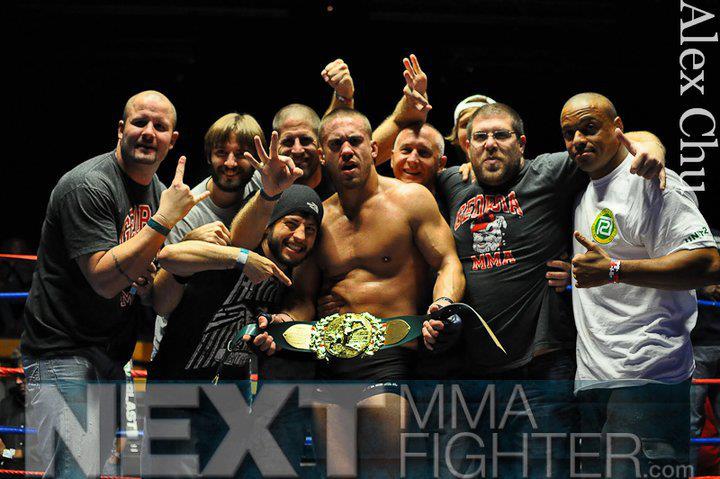 Stephan: So when you said that you were going to coach, had you had much coaching experience at that point? Had you worked one-on-one coaching with a fighter who’s trying to make a run for the big time?
Stephan: So when you said that you were going to coach, had you had much coaching experience at that point? Had you worked one-on-one coaching with a fighter who’s trying to make a run for the big time?
Adam: I had no coaching experience at that point initially; I don’t know if it’s just the way my brain works because I’m an engineer by trade and a scientist by education, but I believe I have some really solid leadership qualities.
Matt Thornton really helped me develop how to teach, how to coach, and how to help people learn for themselves. I dove into the pool and really started studying coaching.. I could sit down and just pick Pat Militech’s brain. I could pick Robert Follis’s brain… whoever I could find. I read books and I studied.
Even now I just took a coaching course with Matt Thornton a couple of months ago. I’m talking with John Cavanaugh who’s probably one of the top coaches in the world – I’m talking to him all the time, refining what I’m doing and learning the tricks. Spending time with my coach Roberto Traven, learning how to coach. That’s what I do. That’s my love.
Stephan: It’s often under-appreciated that fighting performance and coaching are two different things. I mean, who would you rather learn boxing from: Mike Tyson or Mike Tyson’s coach?
If you were to learn boxing from Mike Tyson it would be a short and painful experience. You probably wouldn’t learn that much, other than what it feels like to wake up after being knocked out.
Knowing how to train people in something is very different from actually being able to perform those same skills…
Adam: I agree. And what I tried to do, and what I always made sure of, is that I was always on the mats doing all the rounds that the guys were doing. So when I was coaching Forrest, Cale Yarbrough who was on TUF, and my brother Rory Singer, and all these guys, I was also one of their training partners.
I was never the best guy in the world but I have decent skills and I’m very technical. It’s important for me to also be on the mat performing as I was learning how to coach. I think those things together gave me a unique perspective and really allowed me to help my guys maybe a little differently than some other coaches.
I think you’re seeing that also with a lot of the top coaches now: they came up through the sport, they were on the mat…
Maybe they had no competitive career, or maybe they had a small competitive career, but they understand what the fighters are going through. They understand the wear and tear on the body. They understand how these things interconnect. So it’s not necessarily the same as learning from Mike Tyson, but it is learning from someone that has the experience.
Stephan: Well you’ve done the coaching, and you’ve done the training. But have you done much of the managing? You know, the art of sitting down and negotiating contracts, or is that something you let other people take care of?
Adam: My brother got into that for a little while and he didn’t like it. That is not for me. I don’t like talking to a promoters, I don’t like talking about money. They always just tell me ‘this is the suggested opponent‘ and then I just give a yes or a no, basically. That was my involvement in ‘management.’
Stephan: You mentioned the wear and tear on a fighter’s body, and that’s actually something that I really wanted to talk about for today. As opposed to talking in the abstract, can you give us an example of the wear and tear that has happened to some of the fighters that you’ve trained?
Adam: Well, I’ll use Forrest as an example because I was there with him on day 1, and I’m still with him at the end of his career as he’s retired.
He has a shoulder that’s barely functional. He’s had another knee surgery. He’s probably got a bunch of other things that hurt as well that, but because he hasn’t had surgery on them I don’t even know about. But at 36 years old, he has a lot of injuries and things that some he’ll never really recover from.
And we’re seeing other guys with those same things. It’s no different than a football player who retires after a 5 or 6-year player in the NFL. I know football players who they can’t pick up their kids anymore. They can’t lift an arm over their head. I’ve seen NFL players who have a hard time getting out of bed in the morning. Their bodies are just destroyed.
It’s no different with MMA. It’s not just the damage that we see in the fights, necessarily. It’s all the time leading up to those fights. It’s all the training, the year-round banging away in the gym, everything that they need to do to keep that professional career. And it just wears on you. It just builds up over time.
You know football players practice and play, and then they have an off-season. But most MMA guys don’t really have an off-season. When you’re a young amateur or a young pro, then you’re training year-round because you have to be prepared to take fights.
The pervasive paradigm in the sport right now is based on training really hard, and sparring hard with tough partners, and heavy conditioning, and heavy strength training. I think it wears on you, and I think that we will see more guys who are going to have long term ramifications to their health. Not just from concussive injuries, but also just their joints and body parts wearing out. What’s Dominic Cruz’s knee going to be like in 5 or 10 years?
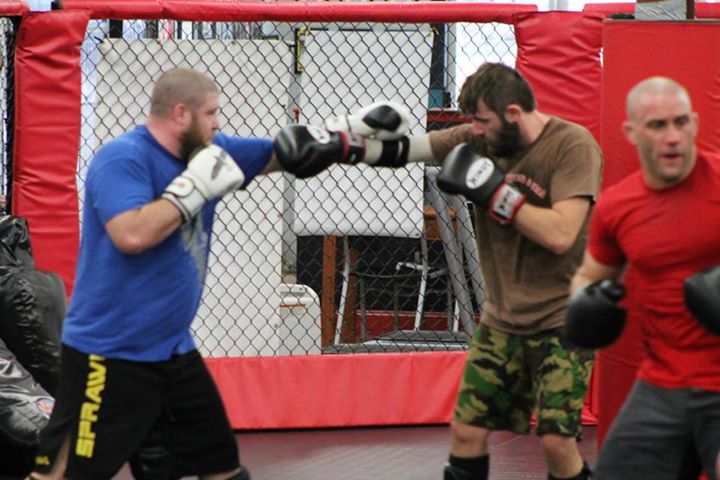 Stephan: Let’s go back to the concussion thing, because of course, the NFL is going through a whole bunch of legal problems and publicity problems. The sport of football is going through some challenges with people realizing the amount of concussive trauma that happens in that sport and the long term effects of it.
Stephan: Let’s go back to the concussion thing, because of course, the NFL is going through a whole bunch of legal problems and publicity problems. The sport of football is going through some challenges with people realizing the amount of concussive trauma that happens in that sport and the long term effects of it.
In soccer and rugby and other sports – boxing obviously – the effects of accumulated concussive and sub-concussive trauma are really becoming understood now, even though it’s not easy to tell when the person has that trauma – short of dissecting their brain which you can only do after they’re dead.
My opinion is that the UFC, and MMA in general, is going to be going through the same thing very, very shortly. I wouldn’t be surprised if we start seeing class-action lawsuits against the UFC for things like CTE and long-term brain damage regardless of whatever waivers the fighter signed. What do you think about that?
Adam: If anyone sues the UFC in 10 years because they didn’t know that they could possibly end up with brain trauma then it’s bullshit.
Now if you played football in the 1960’s or 1970’s, before anyone understood this stuff, then you’re suing for something that nobody knew.
So to me, it’s sort of a catch-22. Everybody who plays football knows, and they start at a young age. It’s years and years of cumulative damage, from high school to college to the professional leagues. It’s terrible – don’t get me wrong – but I have a problem with people pleading ignorance about not knowing what the long-term effects are now.
So the thing about MMA fighters is most of those concussive events don’t even happen in fights. They happen in sparring and they happen in training, and I believe that we can change that aspect of the sport and reduce those concussive effects down the road.
There are people that go their whole MMA career without ever getting knocked out, without ever taking really hard blows in a fight: it’s all during training. Because we still have this mentality in MMA where we want to get together with 10 or 15 other top-level guys, put on the gloves and bang out rounds. And I think we need to move away from that.
The NFL, I’m not sure they can do anything because they have concussive events during practice and during the game. There’s nothing you can do about that. Two 300-pound guys hitting each other is probably not healthy for the body, but these guys know what they’re getting into.
I bet if you ask them, if you laid out the evidence, and asked them, “Do you still want to do this?”, they’d still do it because they’re pro athletes. To the highest level of their sport and achieve what they’ve achieved, they’re willing to make sacrifices. And a lot of times, it’s their health that they’ll sacrifice…
Stephan: But what do you think about the issue of informed consent? You and I, we get presented with this: we’re going to go bungee jumping, we get told that the bungee may snap, and we get asked, “Are you okay with dying?” And we say,“Yes, I’ll sign on the line here.”
But I think it’s a little bit different when you’re talking about kids in their teens, and people in their early 20’s… At that age you think you’re going to live forever. And you also don’t think about the consequences of being 40 years old and not being able to remember your phone number. That just seems so far away. At that age you’re young and stupid.
That’s why that’s the area that I have difficulty with; it’s not so much about the adults making these informed decisions, but it’s more about the youths and adolescents making those decisions because I don’t think they’re informed. They don’t really have a sense of what it’s really like to live for 30 or 40 years with Alzheimer’s-like symptoms, you know. That’s, I think, the tricky gray area for me…
Adam: I agree with you 100%. The problem is if they consider the consequences even further, then you can’t fight because you could die in the ring or the cage. You can have injuries that last forever. You could end up with Alzheimer’s. There are so many things that can happen that if you start dwelling on these dangers, if that’s what comes to the forefront for you, then you can’t fight.
Coming back full circle, I think it’s imperative that as coaches and camps, we change what’s going on in the gym. We can’t change what happens in a fight. If we have good refs then hopefully people don’t take undue damage. In most cases in MMA we don’t see those repeated blows to the head over 30 minutes of a fight. And after a fight we can manage how long it takes to come back to the sport and how long we allow people to rest before getting back to contact training…
I think there are a lot of things we can do, outside of the event itself, to minimise the head trauma. We can’t get rid of it entirely because then we won’t have a sport anymore, but I really believe we can minimize it. In football, maybe you can’t minimise it because you have to hit each other in practice. I think in MMA, I think we can work to minimize some of that.
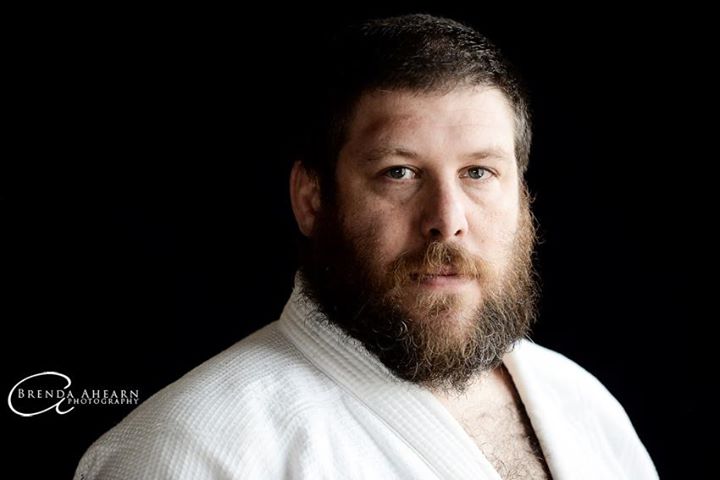 Stephan: So if you and I are both training for fights, then how can we train so that we don’t get hit in the head too hard or too often during training?
Stephan: So if you and I are both training for fights, then how can we train so that we don’t get hit in the head too hard or too often during training?
Adam: Do we really need to hit each other in the head that hard? And if we do, do we need to do it that often? Do we need to do it round after round after round? Do we need to put on the gloves, the head gear and just go at it 2 or 3 times a week?
My buddy, John Kavanagh, is getting a bunch of guys ready for their fights, including Connor McGregor and Gunner Nelson. I know that in their camp, they rarely hit each other hard in the head. And we just talked saw Robbie Lawler talk about not sparring. And we just saw Johnny Hendricks talk about not taking head contact. And I think hopefully those guys will start to pave the way for this kind of training. It starts at the coaching level, obviously…
Stephan: Yeah, it’s really the coach who needs to keep the egos in check so that 2 guys don’t start brawling…
Adam: You have to keep egos in check. You have to make sure that the structure of the program isn’t based on sparring but rather is based on skill training.
And you really have to monitor the contact and the level of training. I’m not saying you can get rid of it in practice. Guys have to hit each other and feel that impact, especially earlier in their career. And as your career goes on you probably need a lot less of that.
Look at the injuries we’re starting to see on these UFC cards; we’re starting to fighters from every card. To me, that’s an issue of training as well. Yet, we still have this mentality in MMA that when you sign a fight, you start a “camp” where you go from whatever level you were formerly training at, all the way to one hundred percent, training 2 times a day, banging away, bringing in guys, and going round after round. I think we can change that mentality a bit. And I think it’s already started…
Stephan: Do you not advocate guys having camps?
Adam: I’m not disadvocating anything. What I’m postulating is that our guys should stay at some level of ability all year round. Our guys should be in some level of shape, fairly close to their fighting weight all year round.
That way, when they find a fight, whether it’s 2 weeks or 12 weeks out, there doesn’t have to be this dramatic difference in their training. I’m still working this out – I’m testing it, Kavanagh is testing it, and friends of mine are testing it – but I almost believe that outside of camp, we should be training twice a day. Mostly skill work, but still twice a day.
And when we get to training camp, we should shrink down the amount of training we’re doing. The intensity can go up a bit but the amount of training shrinks, which is counter to the way most people train.
Most people are very lax in the off-season, outside of camp. And then when camp starts, they start training 2 or 3 times a day. It’s this 12-week countdown, and I don’t know if that’s necessarily the best way to do it. I’m hoping that it sort of changes as time goes on.
Stephan: I’m not a fighter, but I’ve competed in different sports. It’s strange but some of my best performances came from the shortest notice. I think maybe this was just because I just hadn’t had the time to grind myself down. If I had had notice I would have overtrained, “Oh God, the next competition’s in 6 weeks, I better train really hard.”
And then after those 6 hard weeks you’ve got all the accumulated injuries and fatigue from your camp, and you’ve never had the chance to recover. Maybe it’s purely psychological when you’ve got short notice, because then you haven’t sat there worrying about the event for 6 weeks. But maybe it’s also physiological. Maybe just going from regular training to competition is the way to go…
Adam: Right, it’s part physiological, it’s part psychological.
What I’d like to see is more effort put into recovery during the camp phase or the peaking phase. I’d like to see more time put in for recovery, maybe even one-to-one.
If you’re doing a two hour session in a day then I’d like to see 2 hours of recovery work. That would be difficult obviously, bu the idea is to put the same level of care into recovery as go into the training sessions themselves.
I would also like to see more tools that science has to offer being used to monitor recovery. Then we can modify the workouts specifically for each fighter as they move through this peaking phase.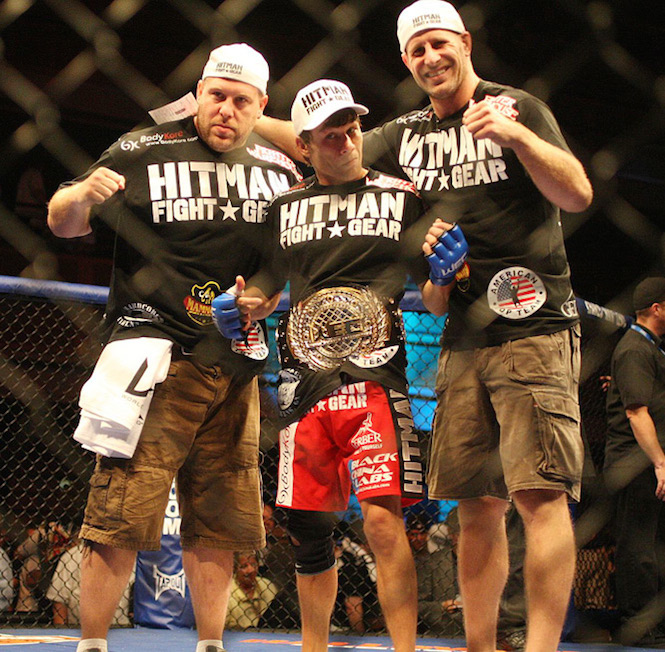
Stephan: What are some of the tools that you found that are useful for recovery for the people you’ve worked with?
Adam: There are some simple tools, like testing grip strength in the morning, testing your pulse rate in the morning, and finger tap testing; these all relate to recovery. And there are some more hi-tech tools now, like HRV monitoring and things like that.
As more money comes into the sport then more things become available. We can have hormone testing and nutritional testing. All these things that are already at the NFL level and pro sports level will start to trickle down to us. And then we’ll get a better picture of what happens to guys as they’re training and as they’re peaking for their fights.
Stephan: So those are all tools that can essentially determine how over-trained you are, or how drained down your reserves are…
But let’s say that I’ve been training hard and one day today my morning heart rate is elevated by 12 beats a minute, my grip strength is down by 25%, and I’m just feeling a bit rotten. What then, as a coach, do you have me do? Of course I’ll want to train. I’ll be saying, “Oh my God, I’ve got to fight 4 weeks from now. I’ve got to train today, I’ve got to be tough here.”
What do you tell me then?
Adam: Well in a perfect world, I don’t fucking care what you want to do. If the numbers are down, or you look rotten, or however I determine that your performance level is down, then it doesn’t matter what you want. It just matters what the evidence is.
If your numbers look like that, then you shouldn’t work out today. Maybe you do yoga, maybe you do a stretching session. Maybe I look at your calories, your nutrition and see if it’s because of too few calories, or a lack of hydration, or you’re not sleeping well because over-training and difficulty sleeping often go together.
We have to look at all the data; it’s a science. We have to look at all the data and if that’s what your numbers look like, the athlete has to trust the coach enough to listen when the coach says, “I want you to come in today, you’ll just do a little bit of jump rope, a little bit of shadow boxing and then do an hour of yoga” or whatever the recommendation is. Hopefully the athlete will understand, trust the coaching staff, and will go do that.
When you’re weight cutting during peaking then you have to pay even more attention on your recovery because we’re taking one of the recovery tools away from you. Sleep is one recovery tool, nutrition is another. If we start reducing your nutrition, then we’ve got to monitor the situation even closer.
Stephan: Because you’re not only cutting calories, you’re also cutting nutrients too…
Adam: Right. You’re cutting all the things that you need to recover. And so we really have to pay attention to that. Camps and coaches are starting to pay more attention to that, but I still think we’re in this survival of the fittest mode in most gyms, where the top guys will be the top guys and the other guys will get washed out of the sport. But I think there’s a lot more we can do for our athletes to help more of them achieve higher levels.
We have some control over the durability of our athletes but there’s a lot of elements there that we don’t control. And we see this in all sports: there are guys with all the talent in the world who just can’t stay healthy. Whether it’s biomechanical issues or some weak structural issues, sometimes there’s nothing we can do about that.
But what we don’t want to do is wear our athletes down and destroy their bodies in practice.
Stephan: Then there are also closet trainers. A friend of mine used to play high level rugby for Wales and he said one of the biggest, toughest guys on the team, who incidentally ended up coming out of the closet years later, would do all the team practices and then sneak off at night when the other guys are going drinking and clubbing. I guess, for obvious reasons he didn’t want to go clubbing with them, but then he’d go work out some more. But he’d keep those workouts quiet; he didn’t want anybody to know that he was doing additional workouts on top of the workouts that everyone else was doing…
Adam: That’s exactly what Forrest did! If I said, “Hey, today, I just want you to take it easy. Let’s do some shadowboxing, some jump rope and some pad work,” he’d agree because he knew not to argue with me. He’d do that and then he’d go home, and then later I’d find out that he went to Atlanta to spar with one of his buddies. He always did that. He was such a pain in the ass when it came to that…
Stephan: Well, it’s an understandable desire, right? He just wanted to make sure every base is covered, that he was doing everything he could. But sometimes doing everything you can is actually doing nothing…
Adam: You should do is as little as possible to get the greatest effect. That, to me, that should be the goal of your practice. To get the desired effects with the least amounts of work.
Any coach can give a “killer workout” that makes guys puke. But not every coach can get guys better day after day, month after month, year after year. And our goal is to do that. So, as a coach, we want to look at the minimal amounts of work required and we shouldn’t really go past that. It’s difficult!
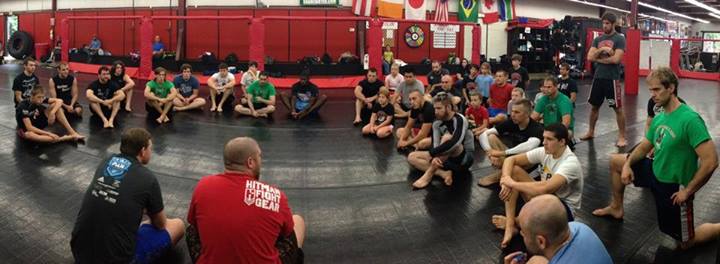 Stephan: So what is the minimum amount of conditioning for most people who want to fight at a high level? Obviously, it’s athlete-specific, but what, on average, do you find that most guys need?
Stephan: So what is the minimum amount of conditioning for most people who want to fight at a high level? Obviously, it’s athlete-specific, but what, on average, do you find that most guys need?
Adam: So the best answer I could give for that right now is that I’m not totally sure. I go back and forth on this a lot.
You know, we went through the period a little while ago where it was all about caveman training. Everyone bought a tire and a sledgehammer. And then everyone is doing sprints, and then everyone is doing crazy Olympic thing, and then everyone’s got kettle bells. And I don’t know how much of that is really necessary, if at all.
So I don’t know what the answer is, but at some point I’m going to have been an MMA coach for almost 20 years, and I think the concept of ‘less is more’ also applies to strength and conditioning. I think there’s a baseline of strength that most athletes need to accomplish their goals. And once those baselines are achieved, then I don’t see any reason to kill yourself in the gym lifting weights and stuff.
Stephan: Can you give us an example of what a minimum standard should be? Let’s say a 6′ tall, 200 lb fighter…
Adam: I’m not trying to be evasive, but like how does that guy fight? Is that guy going to clinch people, put them on a cage and wear them out with the upper body? Or is that guy going to dance around, stick and move, move and sprawl? Is he a super strict jiu-jitsu guy, or is he all about just explosiveness, getting up and pushing the pace?
So I’m not trying to be evasive, but it is an individual thing and it’s got to be based on the fighter’s weaknesses as well as the fighter’s game: what they’re good at and what they do and how they fight.
But I’ll tell you this, you see very few UFC fights lost because one guy was so much stronger than the other.
You see plenty of fights lost because one guy was technically superior in an area. We see a tremendous number of fights lost because of poor cardiovascular conditioning. But we rarely see fights lost because one guy was just stronger than the other guy, had a bigger bench press or deadlift.
So for me, the conditioning, has got to start sport-specific, and then we go from there. For a lot of years I never understood why boxers ran so much, why boxers did so much road work. And then over time, I realised that boxing is an aerobic sport. There are short bursts of effort, but the recovery between those short bursts, the ability to keep moving and hitting, is aerobic.
And so I would rather see guys spend their time doing the sport – specific conditioning – and then build off of there. Does that make sense?
Stephan: I can only think of a few examples where sheer strength has ruled the day. Escaping a submission or lifting somebody up. But I would agree with you that 8 times out of 10, when someone loses because of conditioning, it’s because of their aerobic and anaerobic conditioning, not because of their muscular endurance or their maximum strength.
Personally with my own jiu-jitsu, I’ve tried sprints, I’ve tried long cardio, I’ve tried circuit training… In the end it always comes back to the fact that I feel best when I’m doing a couple of sessions of long cardio each week. Maybe it’s just my game but that’s where I feel best. So I do have to agree with you about cardio is king; it seems like a lot of people come to that conclusion after going down a whole lot of different roads. So then, how do you like get guys to do cardio?
Adam: The easiest overall prescription I would give is very simple weight training, done as minimally as possible, mixed with some level of cardiovascular training.
Everything starts with the training itself, and then it goes from there. So is it more beneficial to get road work or would it be more beneficial to hit the heavy bag? Would it be more beneficial to do sprint work or would it be more beneficial to do focus mitt session? Now if you’ve got time and recovery to do both, then we start to look at what can be added: what can you recover from and what can you physically handle?
I like long, steady state aerobic training as well. I like it even as a recovery device. Put on your heart rate monitor, get your heart rate up to about 135 or 140, and just walk. Walk up a hill wearing a vest. I think it’s a great recovery tool and I think it helps your heart rate. Joel Jamieson, who is Demetrious “Mighty Mouse” Johnson’s strength and conditioning coach, is doing some really good work in that area. There are very few guys on the planet that can keep up with Demetrious’s shots.
You know, I’m not saying there’s no place for weight training. As a young athlete, it’s important to build a base of strength. I think it helps you against being injured. I think it helps stabilize your joints. I think it helps you do things you wouldn’t otherwise be able to do. But the focus on strength and conditioning over the focus on skill work, that’s a mistake.
Stephan: So let’s talk about Brazilian Jiu-jitsu for a second. There’s a lot of pulling and gripping in jiu-jitsu. So some people think that most your conditioning should consist of pulling and gripping.
The contrarian view here, and I think it’s a point well taken, is that if you’re already doing all this pulling and gripping when you’re doing your sport, then in your conditioning you should be doing the opposite. You should be working the muscles that you aren’t using in the sport to prevent injuries. I
If you’re always pulling with your right hand in whatever techniques you do, and then you go to the gym and say, “Okay, I get even better with pulling with my right hand,” then you’re going to asymetrically develop your body. And that asymmetrical development will set you up for major pain down the road.
I think it ties in with what you said about keeping your weight training as simple as possible. That will make sure that you’re getting a balanced physique, and that you don’t have one set of muscles that’s much stronger than another set of muscles. You’re going develop your pushing muscles AND your pulling muscles. You’ll make sure that your upper body is proportionately as strong as your lower body. That the front of your body is as well-developed as the back of your body.
Then you can do your sports-specific stuff by actually doing your sport, not by doing the one-handed tractor tire pull over and over and over.
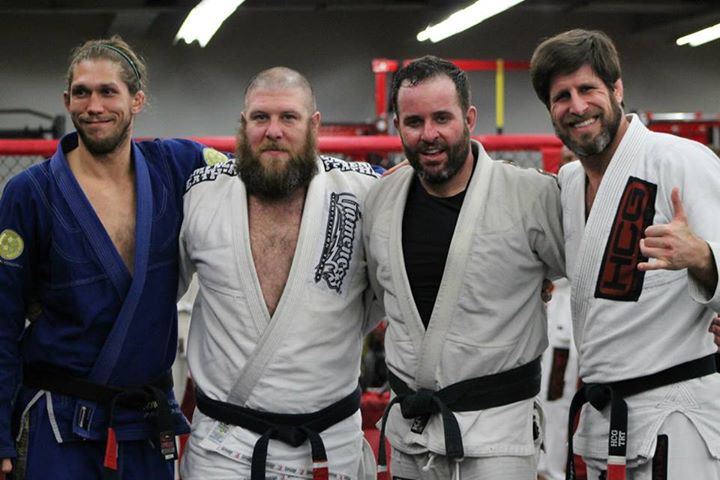 Adam: Right. I agree 100%. We have to build balance. In the early stages of the career of the athlete in any sport, I believe that building a balanced strong body is going to give you the most bang for your buck over time.
Adam: Right. I agree 100%. We have to build balance. In the early stages of the career of the athlete in any sport, I believe that building a balanced strong body is going to give you the most bang for your buck over time.
Then we do the sport.
And then we identify weaknesses. And we have to really think whether these are weaknesses we can fix through strength and conditioning, or whether we can fix these weaknesses we can fix with technical ability?
So we can’t just throw things at the problem and assume they’re going to fix them. We really have to be smarter than that. We have to be willing to test. To coach athletes at a high level takes time because there’s a lot of trial and error, there’s a lot of failing, and there’s a lot of having to change if you want to keep things successful.
Part of the problem is at the amateur and low level pro level, you can win a lot of fights just being more athletic than people. And then people take that to mean that that’s how we should continue training. Then those guys get weeded out because they lack the technical ability. Once they meet a guy who has the same athletic ability plus technique, and then they lose!
So I believe the technical skills training has to make up the majority of your work, especially when you’re young, but even as you move through. I think that people abandon technical work too early in their career and replace it with sparring and intense training, and I think that’s part of the reason we see some lack of technique even at the UFC level. Even now, we see guys whose boxing is rudimentary at best, whose footwork is sub-par, whose wrestling is not where it should be, whose jiu-jitsu is not where it should be All of those areas need technical work, and if all you do is come in and spar, come in and roll, come in and wrestle, then it’s really difficult to build that.
Stephan: You’ll be tough, but not skilled…
Adam: You’ll be tough, and if you’re athletic, that can take you further. Being athletic is always better than being not athletic. Athletic plus little skill work can get you into UFC.
But at the end of the day, the guys who are the champions, the guys who are in the sport for a long time, have a balance of that. What I’m stressing is we have to find a proper balance with all of this. How much sparring? How much skill work? How much strength and conditioning? Are we recovering enough?
Stephan: So when it comes to technical training, I see there being striking modalities, clinching and takedown modalities, and ground modalities.
Let’s go through those one at a time and talk about what your preferences are…
The 2 dominant striking paradigms in MMA are western boxing or Muay Thai perspective. Then of course there are a few other guys, like Lyoto Machida, who are coming at it from sort of a hybrid Shotokan karate thing, but I think it’s fair to say that 90% of the guys are either boxing or Muay Thai based.
Which of those two arts do you think is more applicable to MMA? If someone wanted to fight in the UFC in 5 years would you advise them to go to Muay Thai school or a Boxing school and I want to fight in the UFC in 5 years, then what would you tell them?
Adam: If you’re going to hold my feet to the fire there, I’d say boxing.
Stephan: Why?
Adam: Well first off, I’m biased, because that’s what I like. I like the footwork, the ability to change ranges, the ability to add your shots and your sprawls. And I think you can add the kicking later. If you develop a strong boxing framework, I think you can add the kicking to it. We see that with Cain, we see that with Edgar, we see that with other people.
Don’t get me wrong. Thai boxing is a fantastic art, but if you’re holding my feet to the fire, I like boxing more. I believe you can be a champion and never, ever throw a kick, but I don’t believe you can be a champion and never ever throw a punch.
Stephan: Of course here we’re making this an either/or thing, and in real life, it’s not either/or…
Adam: Right. In real life, I like to call my guys box-kickers. We’ll trademark that term right now.
So I spend the majority of our time on really technical boxing. But I’m very cognisant that it changes because it’s MMA; the range has to change a bit, the defense changes, the footwork changes…
So let’s call it a modified boxing, which is basically hand-dominant. Then we can add some of the more effective kicking. I’ve studied with Rob Kaman, I just did a Dutch kickboxing seminar, I studied Rick Roufus – I love the Dutch style. So if you had said boxing versus the Dutch style, I may have wavered a little more, but I’m still going to say boxing.
Stephan: Well, in this imaginary world, where it’s either one or the other, what about wrestling? If the goal is to become good at MMA, should I go into Greco or more of a freestyle wrestling?
Adam: So I’m going to change that question a little bit. Either you grew up wrestling or you didn’t, right?
If you grew up wrestling, you probably were exposed to a little or all of it. In America, it’s folk style, but most do some Greco and some freestyle. If you grew up wrestling, then you need to learn how to use that wrestling in MMA. So you have to adapt that wrestling for MMA. And we’ve seen guys that are very good at it, and we’ve also seen guys with high wrestling pedigrees that are not very good at it. So you need the right coach that understands how to mix striking and wrestling.
If you didn’t wrestle before, and you need to get up to speed so you can fight against wrestlers, then I think you have to focus on the cage, first and foremost. And you have to focus on being able to get up from the floor because a good wrestler will take you down. If you’re throwing punches at someone, then a wrestler will time it and take you down. So you have to be one of those people who are just constantly getting up. Pushing the pace, popping back up, defending and getting back up.
And then spend a lot of time against the cage. I’m not a high level wrestler, but on the cage I can take a high level wrestler down. I can’t take a high level wrestler down in the middle of a mat. I’ve tried and it doesn’t happen. I can’t do it. You put me against a D1 All-American wrestler in the middle of a wrestling mat, then I’m going to get taken down 9 out of 10 times. But if you put us against a cage then I can hold my own, I can defend takedowns and I can score some takedowns. Does that make sense?
Stephan: Yes.
Adam: So I like to spend the majority of our time with non-wrestlers learning how to control their distance. Now the wrestler has to shoot from further away. I like to have them lower their level a little bit so we have a little better chance at sprawling, and working towards getting back up immediately. Even if we hit our butts on the mat we don’t want to let the wrestler get our upper body pinned. Because then it really starts to suck, and then we enter the jiu-jitsu world.
Then we spend a lot of time on the cage. And I have my guys shoot and drive people to the cage, even if it’s a real high level wrestler, because I really believe that the cage changes things that much. I can teach my guys to take wrestlers down on the cage, and to defend against takedowns on the cage, a lot better than I can in the middle of the octagon.
But if you previously wrestled at a high level, then we just spend a ton of time with our punch shot training. We spend a ton of time getting the timing down for you to punch and shoot, or to be punched and shoot underneath it. I took a lot of that from Sean Sherk and Greg Nelson. Just punch shot, punch shot. If you wrestled a lot then everyday go the gym, get a partner and work punch shot. Have them throw punches at you, defend the punches and go underneath them. If you start doing that, you can really start to translate your wrestling into MMA.
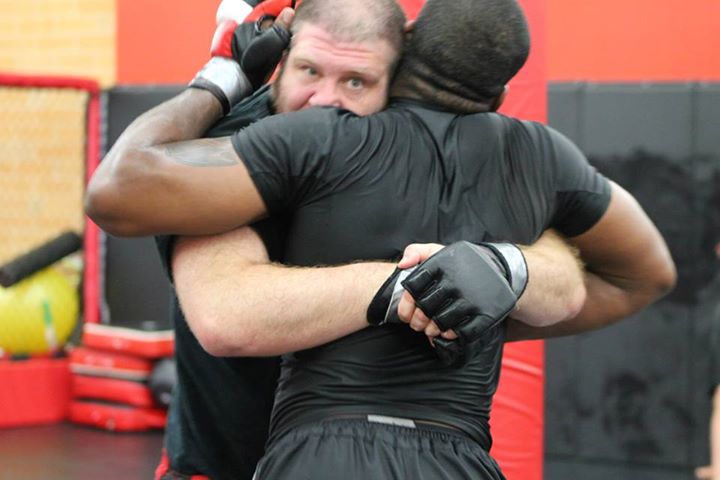 Stephan: Then you can start controlling whether you stay on your feet or go to the ground. And there, ladies and gentlemen, you have one of the major secrets to George St. Pierre’s success…
Stephan: Then you can start controlling whether you stay on your feet or go to the ground. And there, ladies and gentlemen, you have one of the major secrets to George St. Pierre’s success…
Adam: With George St. Pierre, it’s his timing that makes what he does so incredibly powerful. When his fight started with Johnny Hendricks, and as soon as Hendricks put his feet flat to throw a punch, GSP takes him down. It changes the entire dynamic of that fight within the first 20 seconds. And that is a level of timing that we all want to strive for. It’s what separates him from other people that are trying to do the same thing. It’s just beautiful timing.
Stephan: So now we’re on the ground in a position on your back with the shoulders flat on the mat. This is jiu-jitsu country, but when was the last time you saw a submission from the closed guard in MMA? It’s pretty rare nowadays. So how do you adapt your jiu-jitsu to be MMA-applicable?
Adam: So the first thing we work on is getting back up.Wall walking, cage walking, or whatever you want to call it: it’s getting back to your feet. Because no matter how good you are at jiu-jitsu, if you’re on your back, then the refs see you as losing the fight. Even if no damage is being done to you, then it’s still very rare for the refs to view you as winning the fight. So we have to focus, first and foremost, on getting up.
Then I agree with you that we don’t see guys submitting people off the back anymore. To me, sweeps become the key factor now in MMA. I think they’re under-utilized, but I think as we keep going, and guys get to a higher level in MMA, I think we’ll see more sweeps, which can then lead to getting back up or submissions. But at a minimum, we can create a scramble or we can end up on top.
To me, there are 4 things that are going on when you hit the ground. We’ve got to survive, then we’re going to sweep, submission or stand up.
And submit is probably the last of those choices because it’s the hardest one to do, especially later in a fight. So we get up or sweep, and we can cycle those things together and maybe a submission appears. But the idea of being on your back, even if you’re just taking minor punishment while trying to submit someone, you’re going to lose the fight.
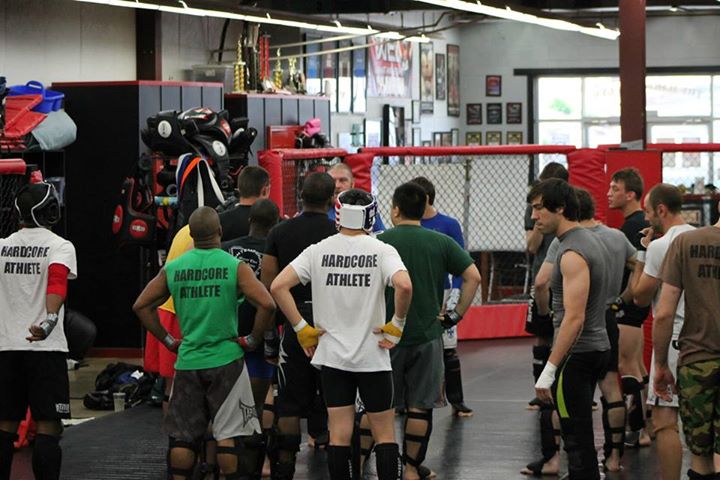 Stephan: So if you’re on your back in an MMA context, it sounds like you’re suggesting that the butterfly guard might be better than the closed guard, because it leads more easily to the sweep and to the standup, rather than hunting for a submission. Are there specific submissions that you’d recommend to your fighters to explore? If they come to you virginally fresh, what direction would you steer them in?
Stephan: So if you’re on your back in an MMA context, it sounds like you’re suggesting that the butterfly guard might be better than the closed guard, because it leads more easily to the sweep and to the standup, rather than hunting for a submission. Are there specific submissions that you’d recommend to your fighters to explore? If they come to you virginally fresh, what direction would you steer them in?
Adam: The first thing is I steer all my guys towards a lot of time in jiu-jitsu. Now I know jiu-jitsu has been minimized in modern MMA a little bit, but if you don’t have jiu-jitsu, then as soon as you’re taken down, you’re going to be in super trouble. So I really stress just doing the solid fundamentals of jiu-jitsu.
Then yeah, I do like the butterfly guard. I like the half butterfly. I’d like to see guys open a little more and attack from an open guard with their feet on the hips, pushing away, creating openings from there.
If you’ve got a killer closed guard (and I don’t know who in MMA really has a killer closed guard) it still gets so difficult to finish anything with the sweat, the cage, and the limited amounts of time you have. I’m not saying that the closed guard is dead in MMA because you’ve got to survive there, but it’s probably a secondary thing at this point for us. Does that make sense?
Stephan: Fair enough, and I think the fact the dominant paradigm of the ground and pounder is working against a closed guard. “Okay, we’re going to work some ground and pound. Where are we going to ground and pound from? Well, he’ll probably get me into closed guard…”
And so the closed guard is what a lot of people train specifically against. Whereas I’ve never seen guys go to the gym and train ground and pound against the butterfly guard with a bear hug.
Also the lack of any kind of clothes. Even the presence of a T-shirt on the street changes things quite a bit, because now, you’re sopping up a lot of that sweat that’s making it so hard to keep somebody’s posture down and keep them under control.
Adam: Look at it this way. If I took a D1 wrestler, and just trained him what NOT to do in your closed guard – what not to do with his arms, what not to do with his posture – and then I sent him up to you, then even though your jiu-jitsu is top notch, that guy is going to be a pain in the ass to deal with.
Now, on top of his balance, his conditioning, his power, now he can also punch you? It becomes a very difficult proposition for the bottom man in closed guard. Now, if you had 20 minutes or 30 minutes to wear this guy out, to set things up, to figure out his reactions, then you’re going to submit him every time. But in a 5 minute round as he gets sweetier and slipperier with no shirt on….
Stephan: That’s really difficult for sure. Of course, there is more to jiu-jitsu than the guard. You can control other positions too. Look at the huge number of fights that have been finished from rear mount. It went from ground and pound to rear mount, and from rear mount to rear naked choke. And really the rear mount came from jiu-jitsu. I don’t know what the statistics are but I’m guessing that nearly 50% of all submissions are from the back probably. So I guess that’s where the art is still immediately useful as an offensive tool, as opposed to a defensive survival tool.
Adam: I think the other thing we’re seeing is these no gi choke wizards now, especially during scrambles. If you make one mistake during a scramble, you’re now seeing these guillotines slapped on so fast and so strong with all these different variations, I think the no gi choking game is moving very quickly right now, over the last few years especially. And as that moves into MMA more, it makes everything even more dangerous. Because if you’re on bottom now, even creating space and coming up opens up the neck attacks and things that we never saw before.
So I don’t think we’re done evolving on the ground yet. I just think that some things are being de-emphasized and some things are being emphasized. For example, we work from all positions for ground and pound, but I would prefer to be in half guard top to ground and pound…
Stephan: You have the Randy Couture philosophy there…
Adam: Right, and he gets full credit for that. He was the first guy to really put that out. Forrest would come back from Vegas, after being at Randy’s for a while, and he was focussed on half guard top. Randy deserves all that credit.
And now the half guard bottom game will really have to develop. The good thing about that is that half guard bottom offers you a lot of sweep opportunities. And so coming full circle, we might see more sweeping coming back into MMA.
Stephan: Well, I’ll give Dana a call and we’ll see if we can do 2 things to modify the UFC. We’ll see about getting rid of gloves to reduce concussive head trauma – we’ll go back 20 years. And we’ll see about putting gis on all the fighters. We’ll can start seeing some of this weird lapel-based play in the middle of all this punching.
That will be an interesting experiment to try, even though it’s never going to happen… Actually, way back in the day there were gi MMA tournaments in Japan. I saw footage of guys fighting with full contact punches and kicks, wearing the gi and grabbing the gi – this was back in the early ‘90’s. So that will be an interesting sport.
Adam: I’ve seen some stuff recently. I think it was called Combat Sambo. It’s fun to do it in your class. If you’re listening and you have a gym put all the guys in gis and then tell them to put on their MMA gloves. First you get weird looks from everyone, but it’s a very fun class. You say, “Okay, we’re doing gi jiu-jitsu like the old days. You could punch each other.” You get a different dynamic and it is a very fun evening and everyone says, “We’ve got to do that again!”
Stephan: I don’t know. Yeah. I’m assuming the weather in Georgia is pretty hot right now, but for a significant portion of North America, for a significant part of the year, you’re not running around wearing only board shorts. You’re usually wearing a jacket or a shirt…
How gauche of me to bring up self-defense in a discussion about MMA, but most of the time when you’re defending yourself, you’re not wearing Speedos and the other guy isn’t wearing gloves. And that means that some of that weird-ass crazy lapel wrapping stuff might possibly have a combative application. I don’t know about the whole worm guard thing that’s making the rounds in the jiu-jitsu community now and creating so much controversy, but who am I to say? It should all be field-tested.
At the end of our talk I’ll give Dana a call and see if I can get rid of the gloves and add the gi in to the next UFC…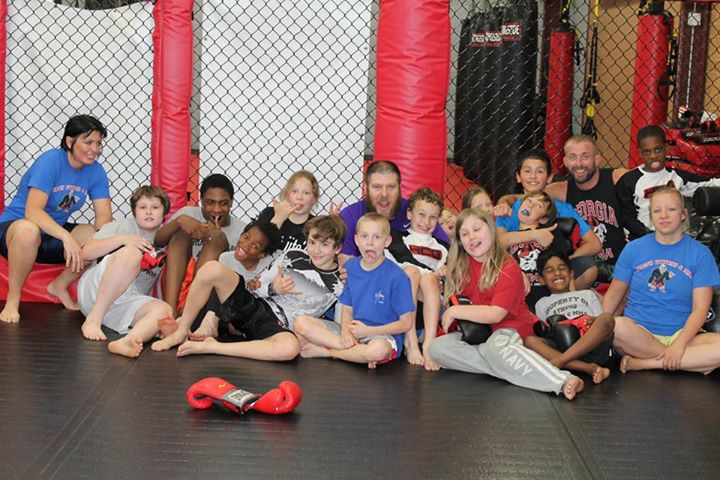
Adam: It’s the nature of sports. I’m huge NFL football fan. I think there’s nowhere in the world where you see evolution of a sport as quickly as you do in the NFL. That’s because of the money, the resources, and the athletes. What happens is you have a set of rules and the sport evolves to beat those rules.
And you see it with MMA, and you see it in jiu-jitsu, and it will not stop. As long as there’s a set of rules and there’s a way to win within those rules, guys will try to game the system. It is natural. At some level, it is healthy, and at some level, it gets strange. But you know, the worm guard is not the craziest thing we’re going to see.
MMA had this period where if you could take the guy down, hump him for 15 minutes, and you could win. You could be world champion. But we see constant evolution. That’s why I love sports.
But just for fun, I think putting on your gi and punching each other in the face is a good time.
Stephan: Well, I can’t think of a better note on which to end our conversation today. So if people want to train with you and find out more about you or your gym, what do they do?
Adam: They can find me at www.thehardcoregym.com. The phone number is (706) 850-8444.
 One thing I didn’t get to say is that I really love training regular people. I want people to come in and be martial artists first. You know, my favorite thing is jiu-jitsu, and over the last few years, I’ve been crazy about the gi. I want people to come in and get a grounding in the martial arts. And then, if people want to fight or they have an aptitude for fighting, then we can go have them do that.
One thing I didn’t get to say is that I really love training regular people. I want people to come in and be martial artists first. You know, my favorite thing is jiu-jitsu, and over the last few years, I’ve been crazy about the gi. I want people to come in and get a grounding in the martial arts. And then, if people want to fight or they have an aptitude for fighting, then we can go have them do that.
But I want people to be martial artists first. I think it allows me to work with the most people and help the most people. It gives you a lifelong pursuit, as opposed to coming in to fight, fighting for a few years, and then not ever doing this anymore. I want to see every fighter earn a black belt in jiu-jitsu. I want to see martial arts become an integral part of our lives, and I think, in the long run, it helps.
Stephan: Well there you go. I couldn’t agree with you more. Have a great day, Adam. Thank you so much for talking to us.
Adam: Thank you very much. I appreciate it.
To contact Adam Singer and the Hardcore Gym to to www.thehardcoregym.com, or call (706) 850-8444.
And click here to download Stephan Kesting’s book A Roadmap for Brazilian Jiu-Jitsu, Your Complete Guide to Learning BJJ Fast
The post Podcast EP22: Adam Singer on Modern MMA Training and Competition appeared first on Grapplearts.

